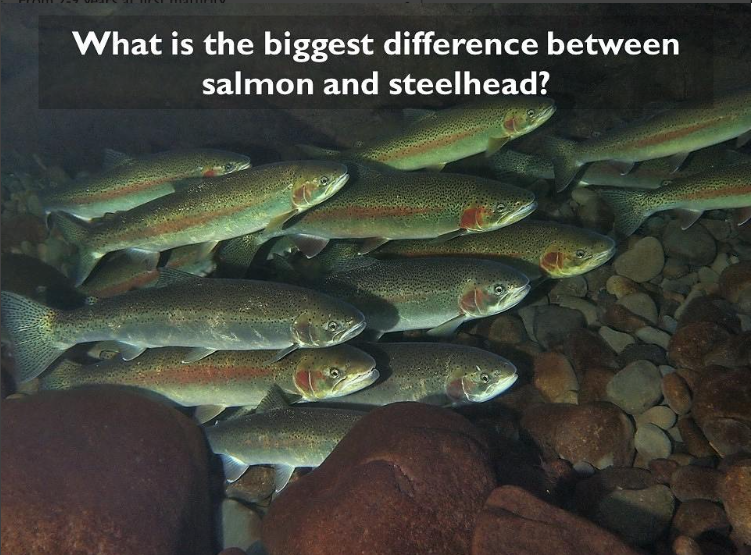From the Instagram account of Keepemwet Fishing Science Ambassador John R McMillan. @rainforest_steel
Let’s begin! Steelhead are a species of #PacificSalmon, which includes sockeye, coho, chum, pink, chinook, steelhead and cutthroat trout – in addition to cherry/masu salmon. They all descended from a common ancestor millions of years ago. Despite the shared genetic heritage, each species has evolved a unique set of characteristics, such as optimal range of temperatures, metabolisms, age at smolting, time spent in ocean, size at maturity, and whether or not they go to the ocean. These attributes differentiate the species, in addition to a variety of other features. The challenge with steelhead is that they are often managed in the same way we manage salmon such as coho, sockeye and kings. In those management schemes we tend focus almost solely on abundance, aka: How many fish do we get back each year? Though an important metric, for a species like steelhead their abundance does not exist within a vacuum, it is partly – and sometimes strongly so – a function of their diversity. The question is then: What is the big difference between steelhead and salmon?
The Skagit River in Washington state provides a good starting point for comparing salmon and steelhead because it has so many species of salmon. I start with #pinksalmon. Here we have the total annual run size of pinks, the number of fish for pinks is on the axis on the right. Below we have #chumsalmon, and their abundance is depicted on the axis to the left. I separated pinks from other species because they are incredibly abundant and make it almost impossible to see the variation in lesser abundant fish. In any case, wow, that is a tremendous amount of variation from year to year in both species. In some years you have over 1.5 millions pinks, in other years you have less than 100k. Similar variability with chum. In some years over 500k return to the Skagit, in other years it is less than 20K. The point is we see a lot of variation among years in terms of run size for these two species. This is probably not a surprise to most anglers. Chum and pink – and sometimes sockeye – have evolved to rely heavily on their abundance as a means of sustaining themselves. Next post I focus on the other species of salmon, and then finally, steelhead, before we get into looking at the diversity within the diversity.
Day 2 of the presentation. Here we have all the other species of salmon and steelhead for the Skagit. The abundance of #cohosalmon, #kingsalmon, and #wildsteelhead is found on the left axis. We can see there is more variation in coho annual run sizes than there is for kings and more variation for kings than there is for steelhead. For instance, coho run sizes have exceeded 400k fish in one year, but are lower than 10K in others. For kings we run sizes from about 7k up to 25k, rarely more, while steelhead are basically going from 3k up to 12k. Essentially, steelhead display the least amount of variation year-to-year in terms of population size. The big question is: Can we attribute any of this variability among species to some aspect of their biology? That is what I will cover in the next slide.
time to look for potential explanations. Life history diversity is one feature that could help explain such variability. For example, in recent years scientists have coined the term “Portfolio Concept,” which basically means that different life histories survive at different rates at different times and places. Such diversity can potentially help dampen annual variability in run sizes by spreading risk across time and space. To determine if that is one cause, we first must identify how many life histories each species displays. Here is a table that describes the number of life histories found in each species. First, I have freshwater life histories: the number smolt age classes in each species. Steelhead have four because smolt ages range from 1-4 years old – though one-year olds are rare in the Skagit. Kings have two, yearlings and sub-yearlings. There is only a single strategy for all other species, sub-yearlings for chum and pink, and yearlings for coho. Next I considered ocean ages, which ranges from 1-4 years for steelhead. For kings we have 2,3, and 4-salt fish, though historically there were also 5-salt. Chum and coho also generally have about 3 age classes for adults, though they tend to be younger than kings. In contrast, all pinks do the same thing – go figure! They are putting all their eggs into one basket each year. Last we have run timing. There are two for steelhead, summers and winters. Same for kings, summer/spring and fall, while there is only one run timing for coho and chum. I gave pinks two run timing because while most are odd year fish, there are a few even year. I was being generous. I think multiplied freshwater life histories by ocean life histories, and then that number by run timing. The result is a total number of potential life histories for each species, excluding repeat spawners for steelhead. And what we see is that #wildsteelheadhave many many more life histories than the other species. Back to my original question: Can this diversity help explain the variation in annual run sizes? I dive into that tomorrow, until then, may the diversity be with you.




